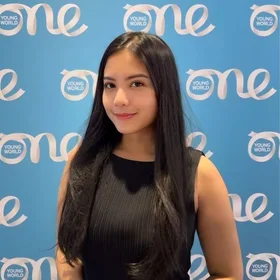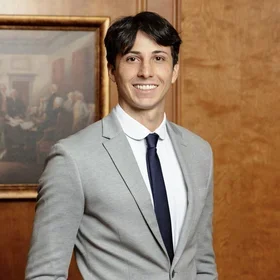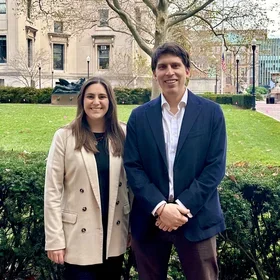By Ellie Hislop, Final Semester Sustainability Management Master’s Candidate, School of Professional Studies
This past summer, I had the privilege of participating in Columbia’s “Clinic on Conflict and Collaboration in Natural Resource Management: Advancing Positive Peace and the SDGs,” an intensive two-week program hosted by the SPS Negotiation and Conflict Resolution program in partnership with Hiroshima University and the Sasakawa Peace Foundation, and led by Columbia University's Dr. Josh Fisher.
From July 31 to August 9, 2024, I, along with five other Columbia students and a global cohort of 40 participants, immersed myself in the complexities of natural resource management, conflict resolution, and peacebuilding, all while gaining firsthand insights into the legacy of Hiroshima.
Understanding Resource Conflicts and the SDGs
The program was designed to address one of the most pressing global challenges: the competing demands for natural resources and their links to crises such as climate change, biodiversity loss, and community displacement. These issues are often exacerbated by conflicts between governments, private industries, and local stakeholders, making collaboration essential to achieving sustainable development goals (SDGs).
Led by Dr. Joshua Fisher, the course emphasized the connections between SDG 16 (Peace, Justice, and Strong Institutions) and other critical goals such as SDG 13 (Climate Action) and SDG 15 (Life on Land). Through intensive workshops, field visits, and policy analysis, we examined real-world case studies, conducted interviews with stakeholders, and synthesized findings into policy briefs tailored to address specific environmental conflicts.
A Global Classroom in Hiroshima
We were based in Saijo, a suburb of Hiroshima, where our cohort represented over a dozen countries, including the U.S., Brazil, Germany, Dominican Republic, India, Myanmar, Indonesia, Philippines, China, Japan, Kazakhstan, Iran, and Ghana. Each participant brought unique perspectives to our discussions, creating a vibrant and dynamic learning environment.
The experience of learning alongside individuals with such varied backgrounds reinforced the importance of incorporating diverse voices into solutions for resource management and sustainability. Together, we explored how collaboration across different sectors and cultures is key to advancing peace and sustainable development.
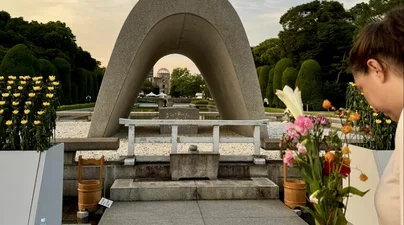
A visitor leaves flowers at the Memorial Cenotaph at Hiroshima Peace Memorial Park.
The Lessons of Hiroshima: A Legacy of Peace
Our time in Hiroshima coincided with the 79th anniversary of the atomic bombing, grounding our studies in the profound history of the city and its commitment to peace. Meeting Keiko Ogura, a survivor of the bombing at just eight years old, was one of the most powerful moments of the trip. Her vivid recollections of that fateful day—helping neighbors covered in burns, unknowingly fetching water contaminated with radiation, and enduring unimaginable loss—left a lasting impression.
On August 6, we attended the Peace Memorial Ceremony, a solemn gathering of representatives from around the world. The event featured speeches from global leaders, the hauntingly beautiful Japanese national anthem sung by a choir, and a poignant performance by a quartet playing instruments made of wood gathered from charred trees near ground zero. The ceremony was a powerful reminder of the catastrophic consequences of nuclear war and a call to action for peace.
The stories of the survivors, known as hibakusha, are central to Japan’s collective memory. However, there is a palpable fear that these stories may fade with time, underscoring the importance of carrying their message forward: “Choose peace every time.”
Insight from Locals: Etajima Island
Beyond the city, our learning expanded to Etajima island, where we met Mineo Nouen Itonamisha, an olive farmer whose story of resilience and reinvention inspired us deeply. After the 2011 Tōhoku earthquake and tsunami devastated Japan’s infrastructure and triggered the Fukushima nuclear disaster, Mineo-san realized the fragility of Japan’s food systems. Motivated to make a change, he joined a government program to revitalize agriculture in depopulated areas.
Over time, Mineo-san transformed Etajima into a hub for sustainable olive farming, earning awards for his olive oil and creating a model for community resilience. His journey highlighted the power of local action to address global challenges like food insecurity and environmental degradation.
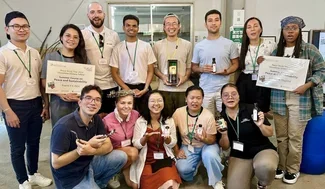
Participants visited the island of Etajima, which has transformed into a hub for sustainable olive farming.
Reflections and Takeaways
This trip was far more than an academic exercise; it was a deeply personal and transformative experience. At the Hiroshima Peace Memorial Museum, guided by the granddaughter of a Hibakusha, I was confronted with haunting artifacts like a schoolboy’s charred lunchbox and a little girl’s burned dress, tangible reminders of the devastating human toll of nuclear weapons.
The program emphasized that meaningful change doesn’t always have to happen on a global scale. From community-led initiatives to grassroots advocacy, impactful work often begins at the local level. Mineo-san’s story of resilience on Etajima Island reinforced this lesson: Small actions can grow into significant transformations when guided by purpose and collaboration.
As I left Hiroshima, I carried with me not only the knowledge gained but also a renewed sense of purpose. The intersection of natural resource management and conflict resolution is not just academic—it is deeply human, rooted in relationships, resilience, and the stories we carry forward.
Hiroshima taught me that the scale of meaningful impact, whether global or local, always begins with action. I am committed to carrying forward the lessons of this journey, advocating for peace and sustainability, and ensuring that the stories of resilience I encountered continue to inspire and guide future generations. This trip was a powerful reminder that while history provides us with lessons, the responsibility to shape a peaceful, sustainable future rests in our hands. Let’s choose peace every time.
About the Program
The Columbia University M.S. in Sustainability Management program, offered by the School of Professional Studies in partnership with the Climate School, provides students cutting-edge policy and management tools they can use to help public and private organizations and governments address environmental impacts and risks, pollution control, and remediation to achieve sustainability.
The fall 2025 application deadline for the M.S. in Sustainability Management program is May 1. Learn more about the program here.
